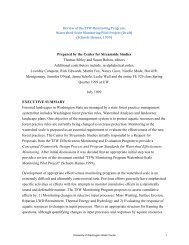Copyright 2012 Aileen M. Echiverri-Cohen - University of Washington
Copyright 2012 Aileen M. Echiverri-Cohen - University of Washington
Copyright 2012 Aileen M. Echiverri-Cohen - University of Washington
You also want an ePaper? Increase the reach of your titles
YUMPU automatically turns print PDFs into web optimized ePapers that Google loves.
from PE than those that made less improvements from PE; whereas the opposite was the case for<br />
individuals treated with SER, with accuracy on lag 3 <strong>of</strong> AB decreasing more in those who made<br />
more improvements from SER than those who made less improvements in SER.<br />
Does Pre-Treatment Inhibitory Functioning (AB and PPI) Predict Changes in PTSD,<br />
Depression, Trait Anxiety, Dissociation, Functioning, and Treatment Drop-out?<br />
To examine the ability <strong>of</strong> pre-treatment inhibition to predict changes in PTSD (PSS-I),<br />
broader psychopathology (BDI, STAI-T, DES), general functioning (SDS), and treatment drop-<br />
out from pre- to post-treatment and from pre- to three-month follow-up, separate mixed model<br />
regressions were run for PPI (30, 60 ms) and AB (lags 3-5). Table 5 shows zero-order<br />
correlations among measures over time. Tables 6 and 7 displays unstandardized regression<br />
coefficients (В) and standard errors <strong>of</strong> variables for change from pre-treatment to post-treatment<br />
and pre-treatment to three-month follow-up, covarying for age. There were no strong<br />
associations between pre-treatment inhibitory processes (AB, PPI) and changes in<br />
psychopathology symptoms, functioning, and treatment dropout from pre-treatment to post-<br />
treatment. Similarly, covarying for age, there were no strong relationships between pre-<br />
treatment inhibitory functioning (AB, PPI) and changes in psychopathology symptoms,<br />
functioning and treatment dropout from pre-treatment to three-month follow-up. Thus, lower<br />
pre-treatment inhibitory functioning as measured by AB and PPI was not predictive <strong>of</strong><br />
improvement in broader psychopathology, general functioning, and treatment drop-out.<br />
Do Individual Difference Factors Predict Pre- to Post-treatment Changes in Inhibition?<br />
To examine the predictive value <strong>of</strong> pre-treatment individual difference predictors on<br />
changes in inhibition from pre- to post-treatment (AB: lags 4, 5; PPI: 30, 60 ms), mixed model<br />
regressions were run using three predictor variables: age, gender (male = 0; female = 1), and<br />
39
















